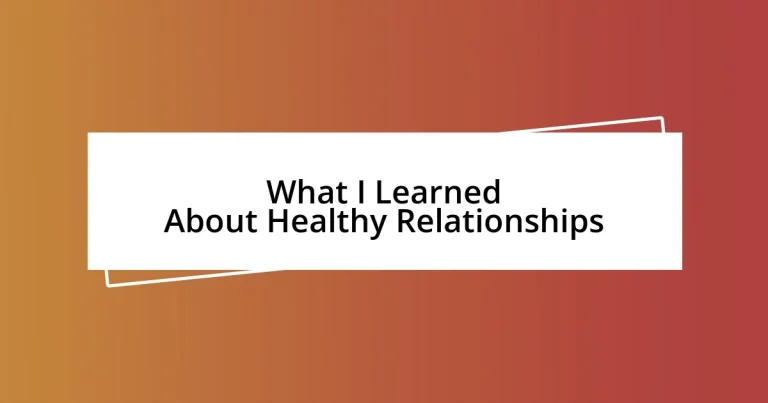Key takeaways:
- Healthy relationships balance give and take, emphasizing effective communication, mutual respect, trust, empathy, and support.
- Constructive conflict resolution focuses on the issue rather than personal attacks and encourages compromise and understanding.
- Nurturing emotional intimacy involves vulnerability, regular check-ins, and shared experiences, which strengthen connections and trust.
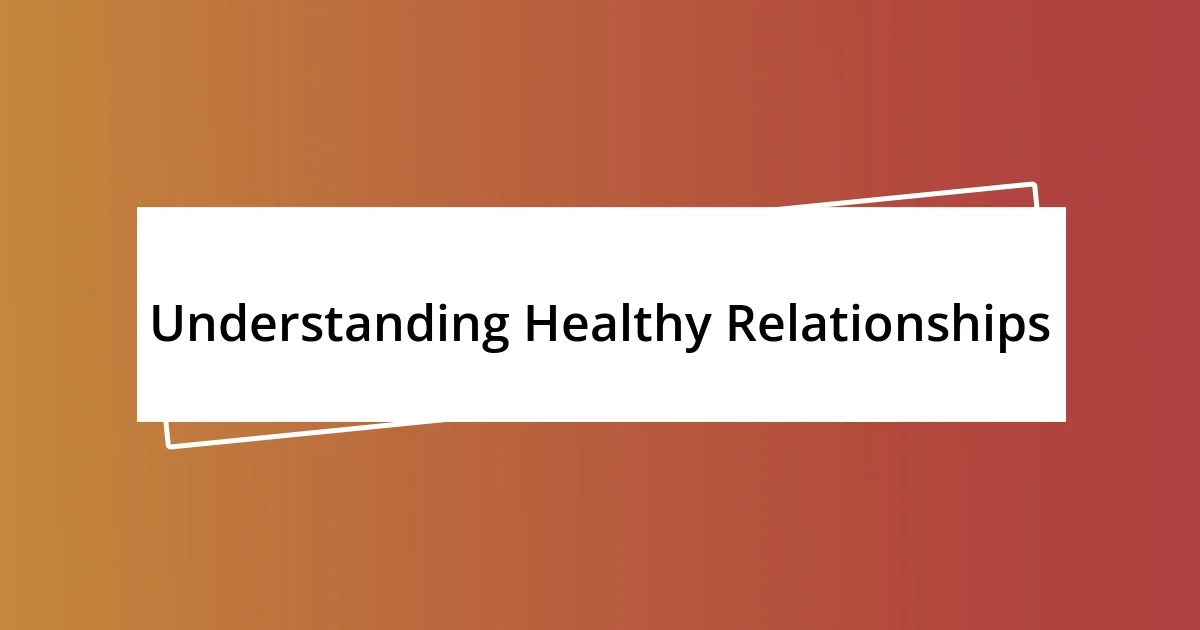
Understanding Healthy Relationships
Understanding healthy relationships is about recognizing the balance of give and take. I once had a friend who would always put their needs before others, and it made me wonder: How can we truly support one another if we aren’t also acknowledging our needs? This balance, I’ve learned, fosters mutual respect and creates a safe space for vulnerability.
Communication stands at the heart of healthy relationships. I remember a time when I had a miscommunication with a close friend that led to hurt feelings. We sat down to talk it out, and in that moment, I realized how vital it is to express ourselves openly. I asked myself—as much as I value honesty, am I also ready to listen?
Trust is another pillar that cannot be overlooked. In my own experience, trust has often required patience; it’s built slowly over time. When someone breaks your trust, it can feel like a deep wound, reminding me of the importance of consistency and reliability in interactions. What would it take for trust to flourish in your relationships?
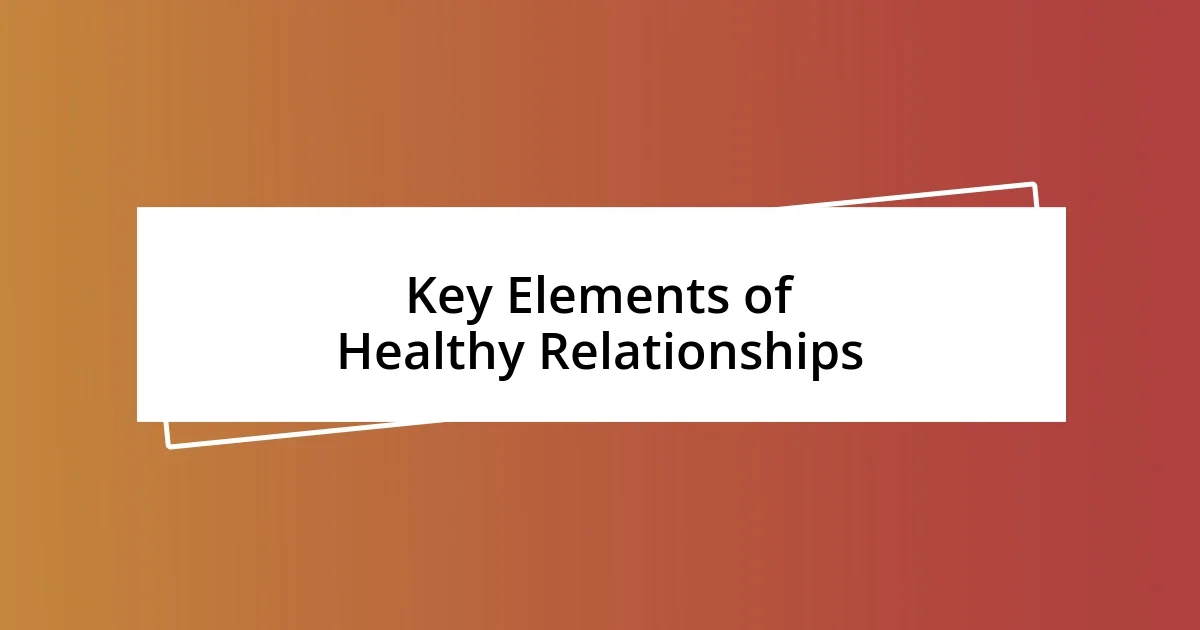
Key Elements of Healthy Relationships
Healthy relationships hinge on several key elements that nurture connection and understanding. For me, the practice of active listening emerges as a crucial factor. I recall a discussion with my partner where, instead of simply waiting for my turn to speak, I focused intently on their feelings. This shift not only deepened our bond but opened avenues of conversation I hadn’t anticipated. It’s incredible how a genuine, attentive ear can transform the dynamics of any relationship.
Consider these essential components that contribute to a thriving, healthy relationship:
- Effective Communication: Share thoughts and feelings openly without fear of judgment.
- Mutual Respect: Valuing each other’s opinions, boundaries, and individuality enhances connection.
- Trust: Building trust takes time, but it’s the foundation for deeper emotional intimacy.
- Empathy: Understanding and relating to your partner’s emotions can strengthen your bond.
- Support: Being there for one another during both triumphs and challenges solidifies the relationship’s strength.
Reflecting on these elements can truly help in cultivating relationships that feel enriching and fulfilling.
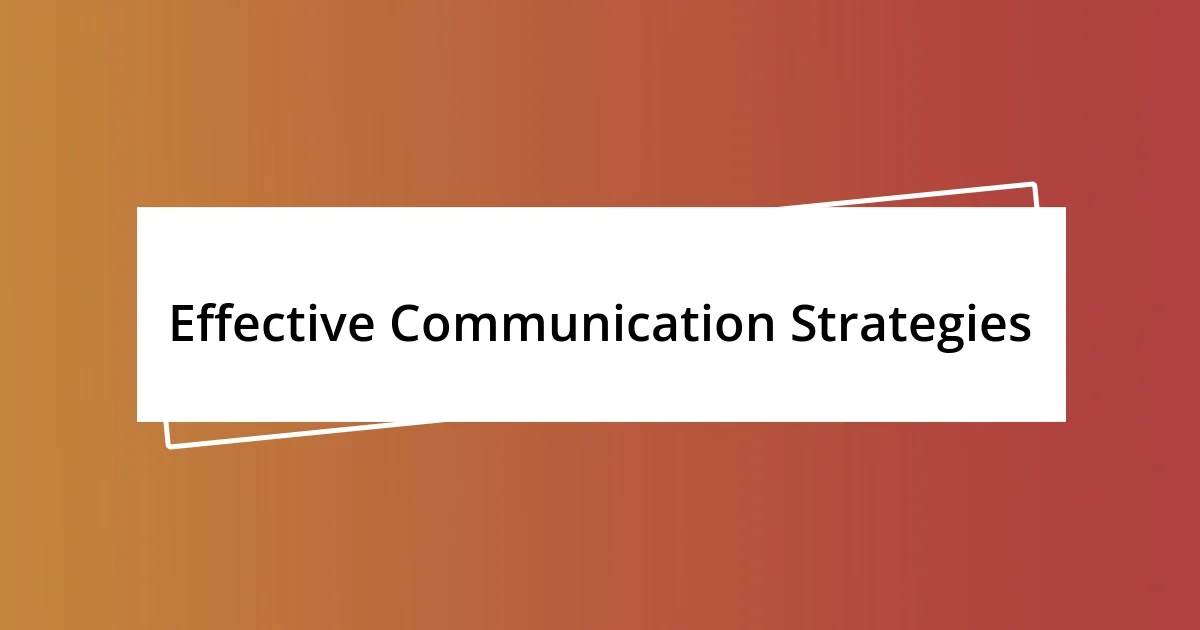
Effective Communication Strategies
Effective communication strategies lay the groundwork for understanding and connection. I’ve discovered that using “I” statements can be transformative. For example, instead of saying “You never listen,” I might express, “I feel unheard when I’m interrupted.” This subtle shift not only softens the message but invites dialogue. It encourages others to reflect on their actions without feeling attacked, creating an atmosphere where open conversation thrives.
It’s also essential to check in with your partner or friend regularly. I remember a period where my partner and I got so caught up in our busy lives that we neglected to ask each other how we were feeling. Once we started scheduling “check-ins,” it was a game changer. Those small, intentional moments allowed us to share our thoughts and feelings freely, reinforcing our connection and ensuring that we were both on the same page.
Lastly, employing nonverbal cues is equally important. I once noticed how my gestures and facial expressions could unintentionally convey my mood during discussions. A simple smile or maintaining eye contact can enhance the message I want to share, letting my conversation partner know that I’m engaged and supportive. By being aware of both what I say and how I say it, I’ve learned that communication can be both meaningful and effective.
| Communication Strategy | Example |
|---|---|
| I Statements | “I feel [emotion] when [situation].” (e.g., “I feel confused when plans change last minute.”) |
| Regular Check-ins | Schedule time to discuss feelings and thoughts, such as weekly meetings. |
| Nonverbal Cues | Use eye contact and gestures to show engagement, such as nodding or leaning in. |
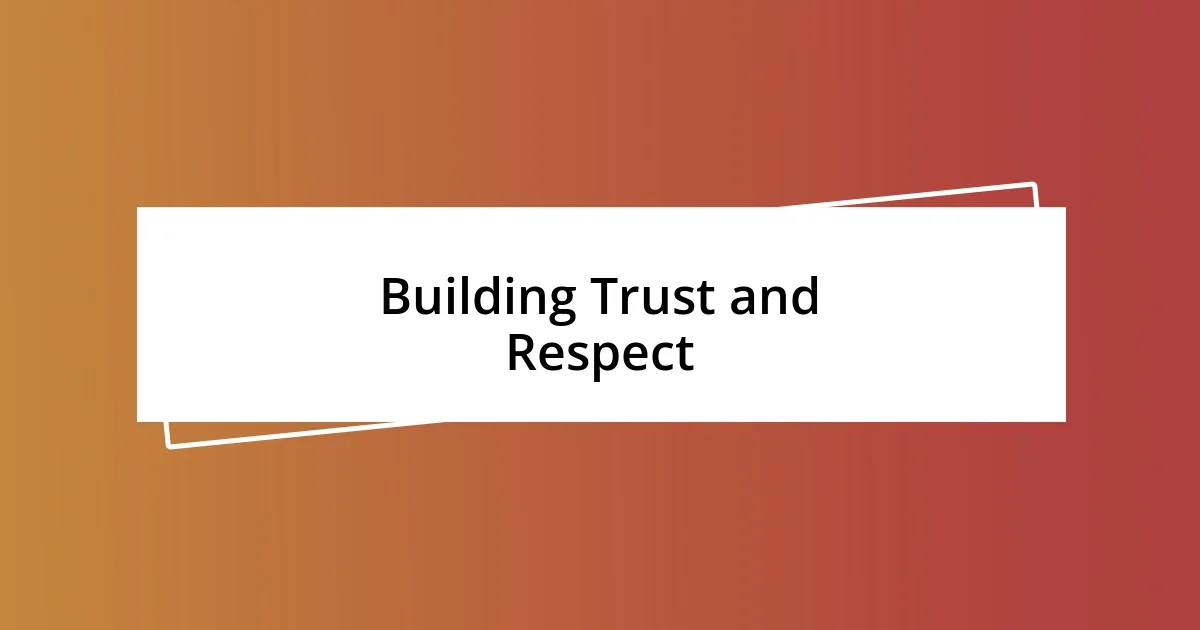
Building Trust and Respect
Building trust and respect in a relationship requires patience and vulnerability. I remember when I first shared a personal struggle with my partner—my insecurities about work. Rather than brushing it off, they listened and offered support without judgment. That moment forged a bond between us, revealing the profound impact of simply being open and trustworthy.
Trust is often built in small, everyday moments. For instance, when my partner says they’ll be home by a certain time, I’ve learned to trust their word because they’ve repeatedly proven they respect our commitments. It’s fascinating how consistency in our actions creates a safety net, allowing both of us to feel secure and valued. Have you ever experienced that small sense of relief when you know you can rely on someone? It’s a crucial part of creating deeper connections in any relationship.
Respect plays a pivotal role in building that trust. I once had a friend whose opinion I didn’t always agree with, yet I made it a point to validate their perspective, even when I felt differently. By acknowledging their feelings, I not only showed respect but also fostered an environment where they felt safe to express themselves. This mutual respect encourages healthy discussions and makes it evident that each person’s view carries weight, strengthening the foundation of our relationship. Isn’t it amazing how respect can transform a conversation?
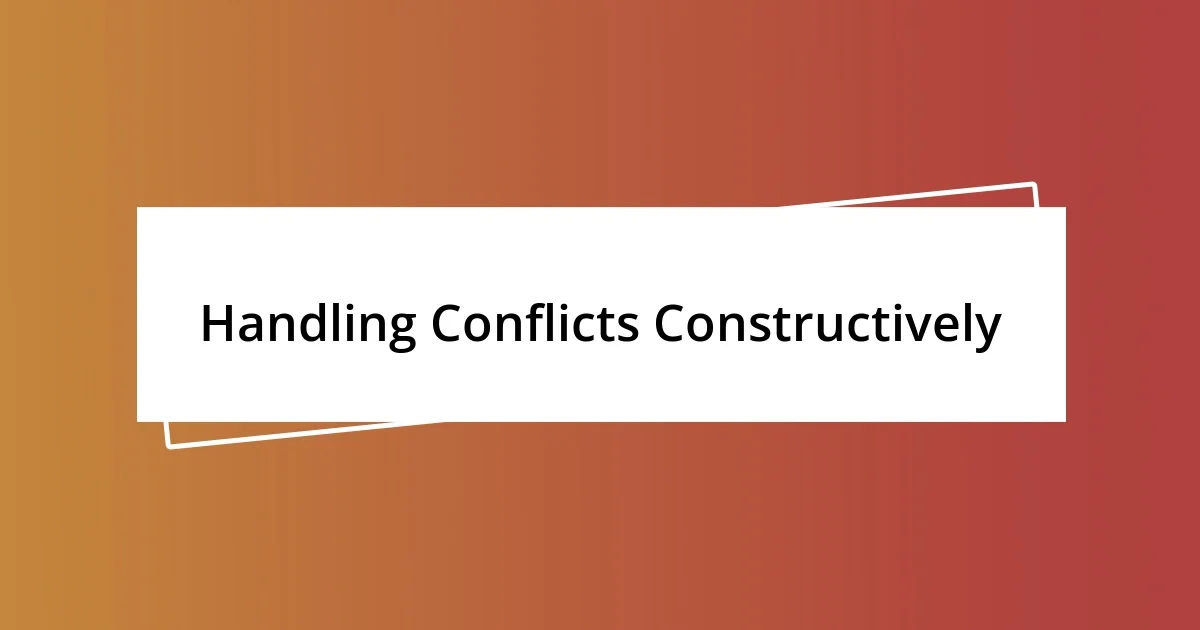
Handling Conflicts Constructively
Handling conflicts constructively requires a mindset shift, turning disagreements into opportunities for growth. I’ve often found that taking a moment to breathe before responding helps me to avoid reacting impulsively. For instance, there was a time when a misunderstanding with a close friend escalated quickly. Instead of letting frustration dictate my response, I paused and considered their perspective. That simple act changed the entire conversation; it shifted from a tense standoff to a genuine dialogue where we both felt heard.
Another vital aspect I’ve learned is the power of focusing on the issue, not the person. When my partner and I faced a disagreement about household chores, I made a conscious effort to address the task itself rather than casting blame. Instead of saying, “You never do your part,” I approached it as, “Let’s find a better way to share the chores.” This approach diffused tension and allowed us to collaborate on a solution, reinforcing our partnership rather than creating a divide. Have you ever caught yourself getting caught in the trap of personal attacks during a conflict? I know I have, and redirecting my focus makes all the difference.
Lastly, I believe in the power of compromise. I recall a heated discussion over vacation plans where each of us had our dream destination in mind. Rather than insisting on my preference, we explored combining elements from both choices. This compromise didn’t just resolve the immediate conflict; it deepened our connection as we recognized the value in each other’s desires. Isn’t it remarkable how meeting halfway can strengthen relationships?
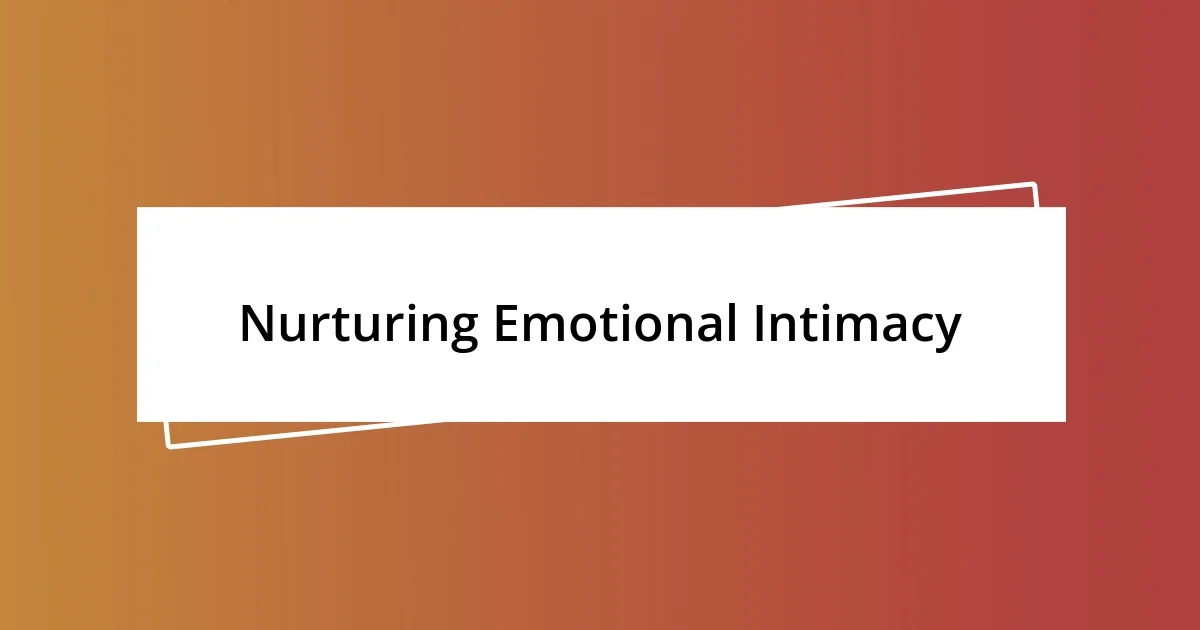
Nurturing Emotional Intimacy
Nurturing emotional intimacy is a journey filled with vulnerability and openness. I vividly remember a weekend when I decided to share my childhood dreams with my partner. It felt risky to expose that part of myself, but their response—genuine interest and encouragement—fostered a sense of closeness that I hadn’t anticipated. Have you ever opened up about something deeply personal and felt that immediate warmth in return? It’s those shared moments that transform a relationship into a true partnership.
Another key aspect I’ve noticed is the importance of regular check-ins. Whether it’s a quick text during the day or a dedicated conversation over dinner, these small acts create a rhythm that strengthens our bond. There was a time when I felt disconnected due to our busy schedules. I suggested a weekly catch-up where we’d share our feelings and experiences. It felt awkward initially, but over time, it blossomed into a cherished ritual where both of us could express what was on our minds. Isn’t it fascinating how a simple commitment to communicate can deepen our understanding of each other?
Additionally, shared experiences contribute immensely to nurturing emotional intimacy. I recall participating in a cooking class with my partner. We tackled the challenge together, laughing over our mistakes and celebrating our successes. Those moments, filled with playfulness, brought us closer as we collaborated toward a common goal. Have you ever discovered how engaging in activities together can peel back layers and reveal deeper emotions? It’s beautiful how shared laughter and teamwork can be the glue that holds a relationship together.
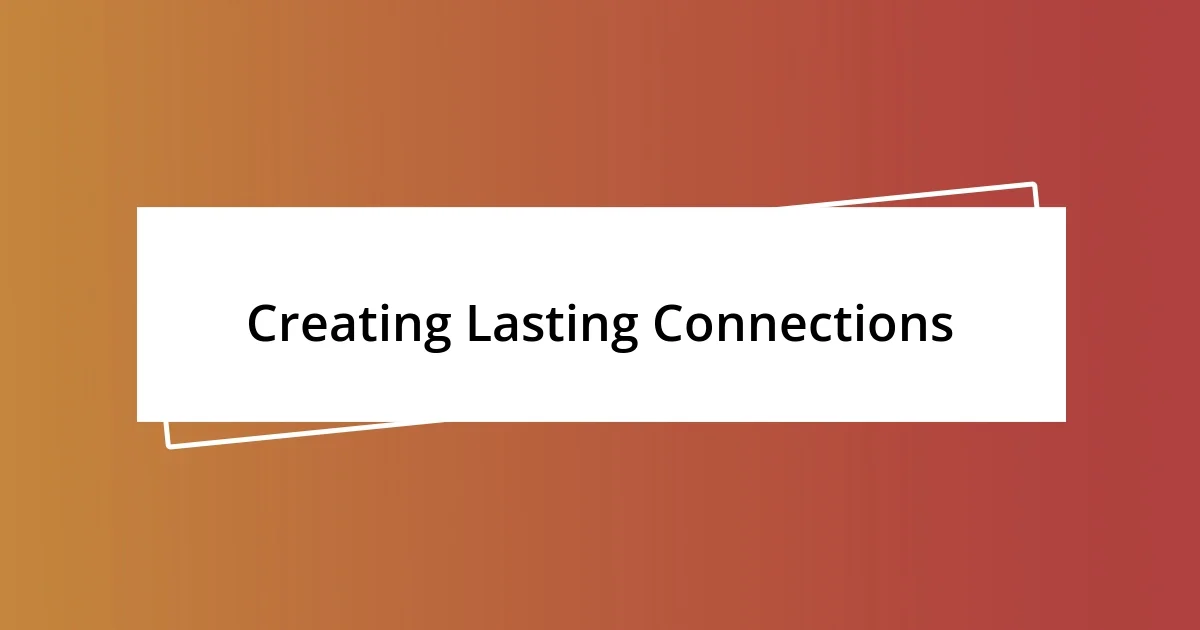
Creating Lasting Connections
Creating lasting connections hinges on vulnerability and authenticity. I remember a moment when I hesitated to ask my friend for support during a tough period. I feared it might be a burden. Finally, I mustered the courage to share my struggle. The relief I felt was instantaneous, and not only did I receive the support I craved, but it also deepened our trust. Have you ever kept something to yourself, only to realize later how much closer you could be by simply letting someone in?
Another essential element in forming lasting connections is consistently making time for one another. I found that life often gets busy, and it’s easy to let meaningful moments slip away. One weekend, I decided to plan a mini-adventure with my partner, complete with a picnic and a hike. That day became a cherished memory, reminding me how creating intentional moments of joy strengthens our bond. How often do you prioritize fun, spontaneous time together in your own relationships?
Moreover, I’ve learned that expressing gratitude can greatly enhance connections. I started writing little notes of appreciation for my loved ones, celebrating their unique contributions to my life. One day, I left a note for my sibling, thanking them for always being there during tough times; it sparked a heartfelt conversation we hadn’t had in years. Isn’t it amazing how acknowledging one another can breathe new life into relationships? Those simple acts become powerful reminders of why we cherish the people in our lives.











